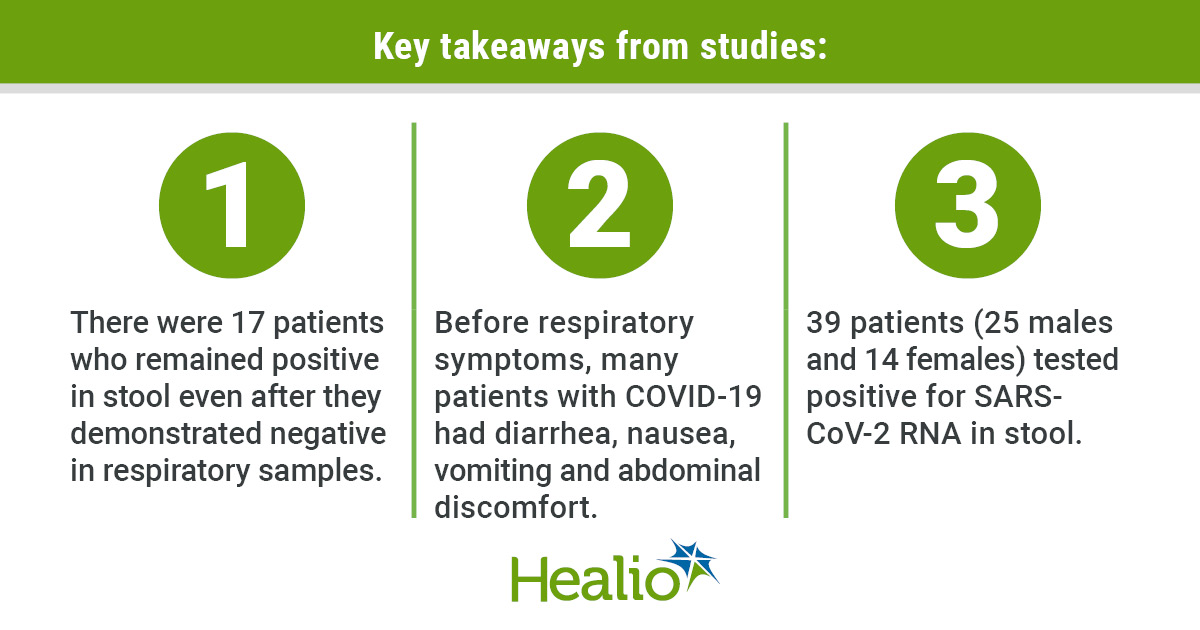Patients with COVID-19 may experience GI symptoms, possible fecal-oral transmission
Results from two studies published in Gastroenterology discussed manifested gastrointestinal symptoms and possible fecal-oral transmission in patients with COVID-19, the disease caused by the novel coronavirus.
“Amounting evidence from former studies of SARS indicated that the gastrointestinal tract (intestine) tropism of SARS coronavirus (SARS-CoV) was verified by the viral detection in biopsy specimens and stool, even in discharged patients, which may partially provide explanations for the gastrointestinal symptoms, potential recurrence and transmission of SARS from persistently shedding human as well,” Jinyang Gu, MD, of the department of transplantation, Xinhua Hospital Affiliated to Shanghai Jiao Tong University School of Medicine, and colleagues wrote in one of the studies.
Digestive symptoms of COVID-19
Two laboratories from China recently reported that they “successfully” isolated live 2019-nCoV from patients’ stool, according to Gu and colleagues.
Before respiratory symptoms, many patients with COVID-19 had diarrhea, nausea, vomiting and abdominal discomfort, according to Gu and colleagues.

“Surprisingly, recent single-cell RNA sequencing data from two independent cohorts revealed a significant enrichment of ACE2 expression in cholangiocytes (59.7% of cells) instead of hepatocytes (2.6% of cells) suggesting that 2019-nCoV might lead to direct damage of intrahepatic bile ducts,” the researchers wrote. “Altogether, many efforts should be made to be alert on the initial digestive symptoms of COVID-19 for early detection, early diagnosis, early isolation and early intervention.”
Signs for SARS-CoV-2
In accordance with Chinese CDC guidelines, Fei Xiao, MD, PhD, of the department of infectious diseases at the Fifth Affiliated Hospital, Sun Yat-sen University, Guangdong, China, and colleagues obtained clinical specimens, which included serum, nasopharyngeal and oropharyngeal swabs, urine, stool and tissues, from 73 patients hospitalized with SARS-CoV-2 between Feb. 1 and 14. Then, using China CDC-standardized quantitative polymerase chain reaction assay, researchers tested specimens for signs of SARS-CoV-2 RNA.
“Our immunofluorescent data showed that ACE2 protein, which has been proved to be a cell receptor for SARS-CoV-2, is abundantly expressed in the glandular cells of gastric, duodenal and rectal epithelia, supporting the entry of SARS-CoV-2 into the host cells,” Xiao and colleagues wrote in the other study.
Endoscopy was used to obtain esophageal, gastric, duodenal and rectal tissues from one patient. In addition, Xiao and colleagues performed histological staining as well as viral receptor ACE2 and viral nucleocapsid staining. Laser scanning confocal microscopy (LSM880, Carl Zeiss MicroImaging) was used to obtain images of fluorescent staining.
Xiao and colleagues found that, of the 73 hospitalized patients with SARS-CoV-2, 39 patients (25 males and 14 females) tested positive for SARS-CoV-2 RNA in stool. Patients who tested positive for SARS-CoV-2 RNA in stool ranged in age from 10 months to 78 years. Investigators noted the duration time of positive stool was between 1 and 12 days. There were 17 patients who remained positive in stool even after they demonstrated negative in respiratory samples.
In the patient in which gastrointestinal endoscopy was performed, the mucous epithelium of esophagus, stomach, duodenum and rectum demonstrated no significant damage with histological staining. Xiao and colleagues noted infiltrate of occasional lymphocytes in esophageal squamous epithelium and in lamina propria of stomach, duodenum and rectum, numerous infiltrating plasma cells and lymphocytes with interstitial edema were observed.
According to the researchers, the viral host receptor ACE2 stained positive mostly in the cytoplasm of gastrointestinal epithelial cells.
“Staining of viral nucleocapsid protein (NP) was visualized in the cytoplasm of gastric, duodenal and rectum glandular epithelial cell, but not in esophageal epithelium,” the researchers wrote. “The positive staining of ACE2 and SARS-CoV-2 was also observed in gastrointestinal epithelium from other patients, who tested positive for SARS-CoV-2 RNA in feces.” – by Monica Jaramillo
Disclosures: The authors report no relevant financial disclosures.

